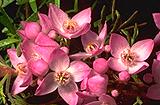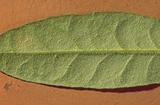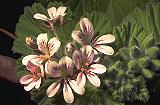|
[Front Page] [Features] [Departments] [SGAP Home Page] [Subscribe]

Australian Plants and Essential Oils
Martin Witchard
Crush a leaf of Prostanthera and a minty smell ensues. Do the same for Backhousia citriodora and a clean, lemon fragrance is evolved. For the sweet-tooth, the flowers of Dichopogon are a mouth-watering delight. Each of these examples has a unique aroma behind which lurks a variety of chemical compositions. What we smell is these chemicals volatilizing (evaporating and dissipating).
There are many synonyms for a smell: odour, fragrance, redolence or bouquet; they all consist of a cocktail of chemical compounds which volatilize at different rates. The first to volatilize is the 'top' note followed by the 'middle' (or body) note and lastly the 'end' note (or 'dry out') of the least volatile components. The chemistry of fragrances can be quite complex for those who are not students of the subject. The compounds come from four main groups: aliphatic (chain hydrocarbons), aromatic (ring ± chain hydrocarbons), terpenes (based on an isoprene sub-unit) and phenols and their derivatives.
 |
The leaves of lemon myrtle, Backhousia citriodora have an intense lemon fragrance.
Select the thumbnail image or plant name for a higher resolution image (37k).
|
In this article we'll examine some aromatic families and genera and try to pin down their active ingredients and how they smell to us. Remember though that the described smell may not be how everyone interprets it; this phenomenon is known as parosmia. Quite often too, the pure compound may smell differently in company of other compounds than when on its own.
Eucalypts - Eucalyptus, Corymbia, Angophora
An aromatically complex group, but it is best to tackle the hard ones first! We all know what the smell of a crushed gum leaf is like and how the strength of the smell can vary from species to species. Indeed, some don't even smell typically Eucalyptus-like. Corymbia citriodora for example has a sharp, lemon odour while E.dives and E.radiata smell positively peppermint.
The typical eucalypt smell is slightly camphor and slightly menthol. This is caused by cineole which in many eucalypts can represent up to 85% of essential oil. This compound is most abundant in E.globulus and E.polybractea. In E.dives and E.radiata the compounds piperitone and piperitol are major components with cineole and impart a 'peppermint' characteristic. This oil is used in scenting preparations and as a precursor to synthesis of menthol (mint scent) and thymol (thyme scent).
Terpenes are widespread in eucalypt oils including camphene (camphor smelling) and terpinene (used in production of resins and lacquers). C.citriodora contains a predominance of citronellol and citronellal over other terpenes. Citronellol is a terpene alcohol used widely as a fragrance material in floral compositions. In its pure form it has a sweet, rose-like odour but in C.citriodora, the overall effect is of citrus. Citronellal is used for perfuming soaps and detergents.
Other eucalypt species containing aromatic ingredients include E.macarthurii (geraniol; geranium scent), E.bakeri (cuminyl alcohol) and E.amygdalina (phellandrene). The odours of these latter examples are also masked by the presence of cineole in the oil.
Melaleuca
The commercial value of tea tree oil has resulted in extensive amounts of information being available. M.alternifolia yields 1-terpinen-4-ol, a terpene alcohol with an 'earthy-spicy' odour. Aside from medicinal uses the oil is used in perfumery for creating herbal and lavender notes. Like the eucalypts there is also a quantity of cineole (approx.10%) in its oil.
Boronia
Complex odour genus. Some species are distinctive in their smell such as B.citriodora (citronellal), B.safrolifera (safrole; sassafras scent, and isosafrole; aniseed scent), and B.thujona (thujone, as smelt in tansy or wormwood leaves).
 |
Like many species of Boronia, the leaves of Boronia safrolifera are highly aromatic.
Select the thumbnail image or plant name for a higher resolution image (36k).
|
Wrigley & Fagg (1990) state that foliage of B.rivularis emits a sarsaparilla scent when crushed. In true sarsaparilla, steroidal saponins (saponin: a bitter glycoside or special sugar molecule) provide the taste but not the smell. As for the other scents of Boronia I can say little from research except that in my experience with B.ledifolia the scent was not altogether unpleasant and faintly musky.
Other Rutaceae
Oil from leaves and twigs of Eriostemon myoporoides yields a simple terpene called ocimene that has only limited use in perfumery. Crowea saligna contains croweacin (a phenol ether) while Geijera parviflora gives xanthoxylin. Neither compound is of commercial significance.
 |
A feature of the Rutaceae is the presence of oil glands on the leaves - seen here as small dots on the leaves of Correa glabra.
Select the thumbnail image or highlighted name for a higher resolution image (31k).
|
Prostanthera
Most of this genus has leaves rich in cineole (cf. Eucalyptus). P.cineolifera is an apt name for a particularly pungent representative. There are few records of essential oil composition in Prostanthera but they undeniably contain terpenes.
Helichrysum/Ozothamnus
Present in the genus Helichrysum, particularly H.angustifolium, is neryl acetate that imparts a sweet, flowery note (especially of roses) to perfumes. Wrigley & Fagg (1990) also note that Ozothamnus diosmifolius and O.rufescens leaves yield a spicy smell when crushed. There are many compounds yielding spicy odours so I will not undertake conjecture as to what they are in this group.
Pelargonium
Only a few native species in this genus. Typical of other Pelargonium, they probably contain pelargonaldehyde (a 'fatty' rose scent) and citronellol. The 'geranium' oils are used extensively in the perfume industry for creating rosy notes, especially in soaps.
 |
Pelargonium australe is a small perennial often found on coastal dunes.
Select the thumbnail image or highlighted name for a higher resolution image (27k).
|
Conclusion
Only the commercial products of Eucalyptus and Melaleuca rate a decent mention in most books concerning essential oils or flavours. The remainder, such as Prostanthera, Boronia, Pittosporum, etc are poorly represented. We have grown up with the scents of rosemary, lavender and pine in our households. How about giving the natives a go?
You may appreciate, having read this short article, that our flora has a wealth of uninvestigated oils. The sheer complexity of the chemistry of essential oils, their derivation and our perception of them is a fascinating topic but the lack of information concerning native species is disheartening.
References
- Bauer, K., D. Garbe & H. Surburg (1990) Common Fragrance and Flavour Materials. VCH, New York
- Gunther, E. (1957), The Essential Oils. D. Van Nostrand, New Jersey, USA.
- Penfold, A. R. (1948), Researches on Essential Oils of the Australian Flora, Volumes 1-3. Museum of Technology and Applied Science, Sydney.
- Trease, G. E. & W. C. Evans (1978), Pharmacognosy. Ballière Tindall, London
- Wrigley, J. & M . Fagg (1990), Aromatic Plants. Angus & Robertson, Sydney.
From the December 1992 issue of "Native Plants for New South Wales", the newsletter of the Australian Plants Society (New South Wales).

[Front Page] [Features] [Departments] [SGAP Home Page] [Subscribe]
Australian Plants online - December 1998
The Society for Growing Australian Plants
|